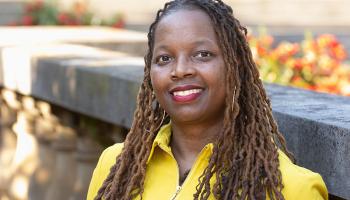Modern Love and Other Mysteries

If you think dating apps are for people who want to date, think again.
Well, of course that's what they're meant for, but for many who use that technology to find their perfect match, the idea of actually meeting someone is the furthest thing from the point. And for those who struggle to make sense of this and other mysteries of romance and relationships in the 21st century, a new book might offer some answers.
Love, Etc., edited by Rita Felski and Camilla Schwartz and published this fall by the University of Virginia Press, explores how modern ideas about love are being reshaped by technology, social media and the shifting norms around partnering, marriage, divorce and feminist and queer thought.
Felski, UVA's John Stewart Bryan Professor of English, and Schwartz, an associate professor of culture and language with the University of Southern Denmark have collected 15 essays covering a wide range of topics and perspectives. From the dating app Tinder to “The Bachelor” reality show, from liking trees to loving aliens, from unrequited love to maternal love, and from polyamory to new stories of female friendship, Felski and Schwartz take readers on a distinctly contemporary tour of the contemporary world of paramours, passions and other perplexities.
Read an excerpt from the book one critic calls “a model of how to write in an engaging and accessible manner without in any way sacrificing academic rigor.” Carolina Bandinelli’s essay, “Digital Romance: Post-Romantic Love in the Time of Dating Apps,” takes a closer look at what love connections mean in a virtual world.
From Love, Etc.
I began my research expecting to collect tales of multiple sexual adventures. Yet to my (initial) surprise, this was not the case. In fact, most of the people I interviewed, despite their habitual use of dating apps, were not dating. Many lamented what they seemed to consider a faulty aspect of the technology: “It doesn’t work!” they would say, referring to the algorithm. Others would blame themselves and their lack of self-branding skills, and they would ask for advice on how to exploit the app and try out different strategies. In some cases, participants were just not interested in going out on a date.
Surely, there are also people who meet other people in the app, and have sex, and fall in love with them; some marry and have children. Yet, what I find interesting is that there are also many who use Tinder without meeting anybody. Actually, for some, the possibility of an actual meeting is to be actively avoided. I was told more than once that while matching with strangers may be nice, meeting them is not desirable. The most eloquent example of this way of using a dating app is a young woman who was a student of mine. In her reflexive journal, she confessed that she used the geolocalization feature of Tinder “against itself,” that is, to make sure that she could match with people who were far enough away, just to reduce the risk of “meeting them,” because “how embarrassing would it be to meet someone you matched with?”
I started thinking about how to make sense of this. During a dinner conversation in our absurdly expensive London flatshare, my brother expressed the paradox in these terms: “it is as if you used Uber to call a taxi when you don’t need a ride, or as if you did a massive order on Deliveroo but then you are not hungry . . . it is the app minus its obvious purpose!” He sounded a bit like Alanis Morissette, but did get the kernel of my research question: What can people do with dating apps besides meeting other people? In other words, how do dating apps work when they do not work? This was a perspectival shift: looking at dating apps not primarily as tools connecting people but rather as objects of connection (and affection) in their own right. I owe this approach to media philosophy, which, since Marshall McLuhan’s claim that “the medium is the message,” has warned against an understanding of technology as a neutral instrument. This is especially true when it comes to digital technology. To quote from Donna Haraway’s “Cyborg Manifesto”: “Our machines are disturbingly lively and we ourselves frighteningly inert. This appears to be the case with dating apps. Humans seem to be not doing much, while apps are very active indeed.
The app entertains, keeps company, gives you something to do. Rose, a woman in her mid-twenties, told me she uses Tinder on hangover Sundays, when she feels lonely. Sarah, her housemate, goes on Tinder when queuing at the local post office or waiting for the bus. Most people I interviewed said, in fact, they don’t even know why they open the app. As theorist Alfie Bown infers, our use of apps is far from rational. Although each app has a manifest purpose, sometimes we reach for our phone and open an application compulsively, getting a form of enjoyment out of it, a state of the body and the mind that involves both pleasure and pain and that escapes our ability to rationally account for it.
What, then, do dating apps offer besides and beyond meeting someone? To be sure, they do provide matches. The phones of apps’ users are full of matches, as was mine during the month I used Tinder. OkCupid and Hinge produce matches by leveraging specific algorithms that calculate affinities based on a set of indicators, while on Tinder, a match happens when two people reciprocally swipe right. However, a match does not necessarily lead to a chat, let alone a date. The vast majority of the people I matched with, for example, did not initiate any interaction.
Initially, I found this frustrating, even offensive. I could not derive any pleasure from being noticed and then ignored, almost simultaneously. “When I was going out and people noticed me, they would ask for my number, they would call me, at least most of the time . . . I mean, they would want to see me, even if they had no super romantic intentions,” I told Sam, a man in his mid-twenties, over a pizza in Covent Garden. We were seated at big tables made of repurposed wood, sipping organic lemonade. “You don’t understand,” he said, “you are using in-person criteria of seduction, but in the digital things are different, a match does not need to lead to a date,” he explained, calmly, amused by my disappointment. As the fieldwork progressed, I understood. A match is not only a means to an end (the embodied date) but also something with a meaning and a purpose in itself. Getting matches would make one feel attractive, or potentially attractive, even if just for a few seconds. It is ephemeral, true, but also infinitely replicable. Matches are tokens of likability that can be accumulated, reproducible signs of possible encounters. They are objectified possibilities that can be stored, counted, looked at. They are pure potentiality, technically reproduced.
Of course, a match can lead to a conversation, or to an attempt. Most chats last for just a handful of messages. Some are prodigious examples of digital hermeticism. Here’s an excerpt from my own phone:
Him: Hello [umbrella, sleigh, pretzel emoticon]
Me: Hello Him: What do you do in London?
Me: I am a lecturer in Media, you?
Him: Digital Project Manager
[The End]
Even when dates do get arranged, they can end brutally for the most trivial reasons. Exemplary is the story of Brad, a student in his early twenties. After months of “unprofitable” use of Tinder, he finally went on a date with a girl. They met in Peterborough for a walk. She spent half an hour talking about her passion for dogs. And when Brad painfully admitted he is allergic to them, she just left.
In the event of a date that really happens, it appears to be still quite difficult for a second or third one to follow. Sam recalled a “successful date”: he described the woman as “very nice” and the evening as “very pleasant,” but still he saw “no reason to go to a second one.” Dating apps seem to impose an unmerciful temporality on romantic encounters. In the space of a date or two, something is supposed to happen. The time span available for chemistry or affinity to emerge is brutally shrunk. The date becomes no more than an opportunity to assess a potential partner, resembling a job interview.
The sense of emptiness that may follow from nonactualized matches, pointless chats, and unsuccessful dates can be countered by going back onto the app, accessing again the virtuality of a thousand possible futures. In this context, the date itself, the “real” date with another human being, is a possibility that has already crystallized; it is already dead. It is the ossified formalization of the seductive magma of possibilities that inhabits the app. No wonder there is little space left for curiosity. But there is not even space for pain. There is no horror vacui to be faced after the brutal end of a beginning. The app will always be there for you.
We’re here to answer your questions! Contact us today.







